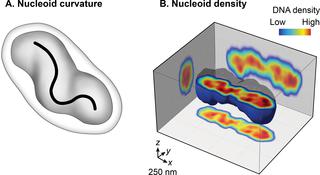当前位置:
X-MOL 学术
›
PLOS Genet.
›
论文详情
Our official English website, www.x-mol.net, welcomes your feedback! (Note: you will need to create a separate account there.)
Architecture of the Escherichia coli nucleoid.
PLOS Genetics ( IF 4.5 ) Pub Date : 2019-12-12 , DOI: 10.1371/journal.pgen.1008456 Subhash C Verma 1 , Zhong Qian 1 , Sankar L Adhya 1
PLOS Genetics ( IF 4.5 ) Pub Date : 2019-12-12 , DOI: 10.1371/journal.pgen.1008456 Subhash C Verma 1 , Zhong Qian 1 , Sankar L Adhya 1
Affiliation

|
How genomes are organized within cells and how the 3D architecture of a genome influences cellular functions are significant questions in biology. A bacterial genomic DNA resides inside cells in a highly condensed and functionally organized form called nucleoid (nucleus-like structure without a nuclear membrane). The Escherichia coli chromosome or nucleoid is composed of the genomic DNA, RNA, and protein. The nucleoid forms by condensation and functional arrangement of a single chromosomal DNA with the help of chromosomal architectural proteins and RNA molecules as well as DNA supercoiling. Although a high-resolution structure of a bacterial nucleoid is yet to come, five decades of research has established the following salient features of the E. coli nucleoid elaborated below: 1) The chromosomal DNA is on the average a negatively supercoiled molecule that is folded as plectonemic loops, which are confined into many independent topological domains due to supercoiling diffusion barriers; 2) The loops spatially organize into megabase size regions called macrodomains, which are defined by more frequent physical interactions among DNA sites within the same macrodomain than between different macrodomains; 3) The condensed and spatially organized DNA takes the form of a helical ellipsoid radially confined in the cell; and 4) The DNA in the chromosome appears to have a condition-dependent 3-D structure that is linked to gene expression so that the nucleoid architecture and gene transcription are tightly interdependent, influencing each other reciprocally. Current advents of high-resolution microscopy, single-molecule analysis and molecular structure determination of the components are expected to reveal the total structure and function of the bacterial nucleoid.
中文翻译:

大肠杆菌核苷的体系结构。
在细胞内如何组织基因组以及基因组的3D结构如何影响细胞功能是生物学中的重要问题。细菌基因组DNA以高度浓缩且功能性组织的形式存在于细胞内部,这种形式称为核苷(无核膜的核样结构)。大肠杆菌的染色体或核苷由基因组DNA,RNA和蛋白质组成。借助染色体结构蛋白和RNA分子以及DNA超螺旋,通过单个染色体DNA的缩合和功能排列形成核苷。尽管细菌核苷的高分辨率结构尚未到来,但五十年的研究已经确定了以下详述的大肠杆菌核苷的以下主要特征:1)染色体DNA平均而言是一个负超螺旋分子,折叠成plectonemic环,由于超螺旋扩散壁垒而被限制在许多独立的拓扑结构域中;2)环在空间上组织成称为宏域的兆碱基大小区域,该区域由相同宏域内的DNA位点之间的相互作用比不同宏域之间更频繁的物理相互作用所定义;3)浓缩且空间组织的DNA呈放射状限制在细胞内的螺旋椭圆体形式;4)染色体中的DNA似乎具有与条件相关的3-D结构,该结构与基因表达相关,因此核苷结构和基因转录紧密相关,相互影响。当前高分辨率显微镜的出现,
更新日期:2019-12-13
中文翻译:

大肠杆菌核苷的体系结构。
在细胞内如何组织基因组以及基因组的3D结构如何影响细胞功能是生物学中的重要问题。细菌基因组DNA以高度浓缩且功能性组织的形式存在于细胞内部,这种形式称为核苷(无核膜的核样结构)。大肠杆菌的染色体或核苷由基因组DNA,RNA和蛋白质组成。借助染色体结构蛋白和RNA分子以及DNA超螺旋,通过单个染色体DNA的缩合和功能排列形成核苷。尽管细菌核苷的高分辨率结构尚未到来,但五十年的研究已经确定了以下详述的大肠杆菌核苷的以下主要特征:1)染色体DNA平均而言是一个负超螺旋分子,折叠成plectonemic环,由于超螺旋扩散壁垒而被限制在许多独立的拓扑结构域中;2)环在空间上组织成称为宏域的兆碱基大小区域,该区域由相同宏域内的DNA位点之间的相互作用比不同宏域之间更频繁的物理相互作用所定义;3)浓缩且空间组织的DNA呈放射状限制在细胞内的螺旋椭圆体形式;4)染色体中的DNA似乎具有与条件相关的3-D结构,该结构与基因表达相关,因此核苷结构和基因转录紧密相关,相互影响。当前高分辨率显微镜的出现,



























 京公网安备 11010802027423号
京公网安备 11010802027423号